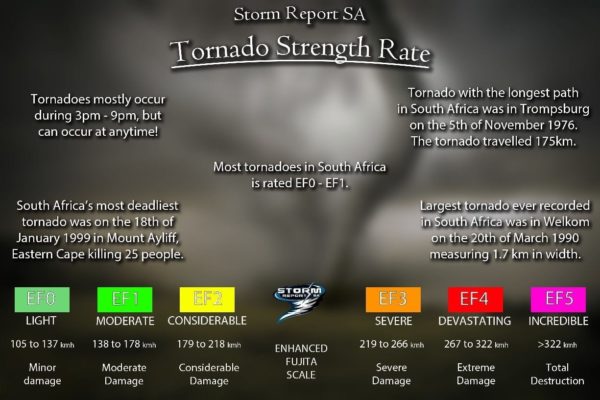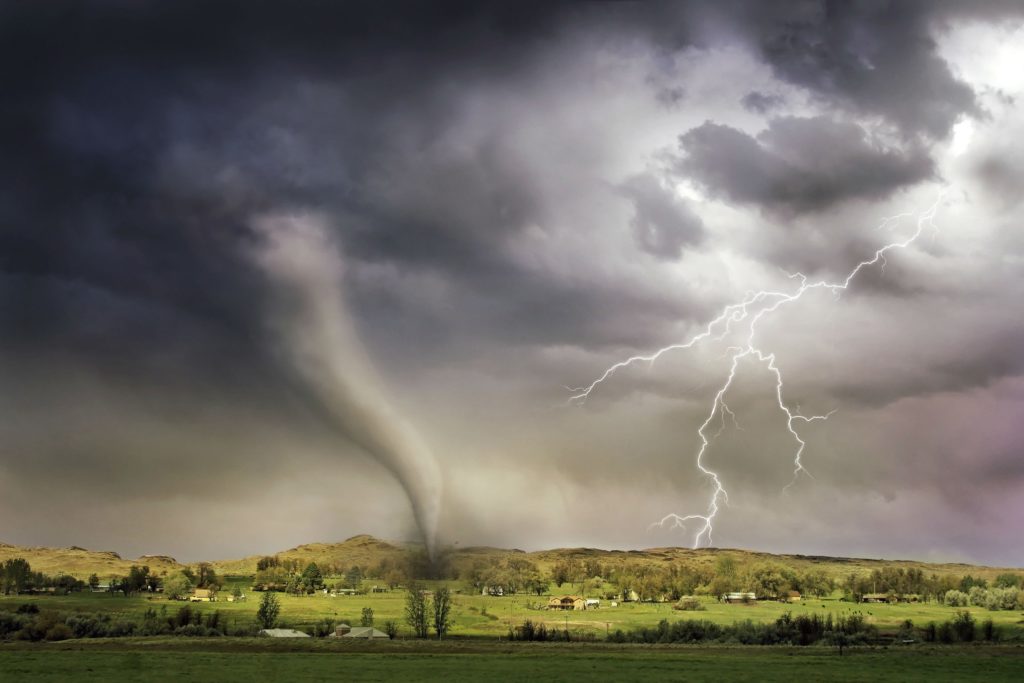South Africa has a history of tornadoes, many of which have created massive destruction over the decades. Some experts warn that tornadoes could become more frequent in the country due to global warming.
A tornado is a violent rotating column of air that extends from a thunderstorm and is much smaller in diameter, typically less than a few hundred metres, but some are larger than 1 km. Tornadoes can last from several seconds to more than an hour, and they usually occur over land. If a tornado occurs over water, is called a water spout.
According to the South African Weather Service (SAWS), tornadoes can occur basically anywhere where a thunderstorm is possible. Most of them have been observed in Gauteng, the Free State, KwaZulu-Natal (along a line from Pietermaritzburg to Ladysmith) and the northern region of the former Transkei.
Most of the events occur in mid-summer from November to January, although a large number of tornadoes have occurred in spring and early summer (September and October) and in the late summer and autumn (February to May).
Interestingly, SAWS also notes that most tornado events in the country (for which the time of the day was available) occurred in the late afternoon or early evening, typically between 4pm and 7pm.
South Africa is no stranger to tornadoes although they are not as severe as ones experienced in other countries. About 65% of tornadoes in South Africa have been classified as F0 or F1 (light damage).
The country’s deadliest tornado, the Mount Ayliff tornado, occurred in the Eastern Cape on January 18, 1999 and was classified as F4 (violent).
The tornado ripped through areas surrounding Mount Ayliff and Tabankulu, leaving mass destruction in its wake. About 95% of residents in the area were left homeless and 25 people were killed, while about 500 people were injured.
The largest tornado ever recorded in the country was when a multi-vortex tornado raced through the suburbs of Welkom in the Free State on March 20, 1990, with a 240 km long severe storm front and a width of up to 1.7 km. Up to 4000 homes were destroyed, causing more than R230-million worth of structural damage.
Another one of the worst tornadoes the country has experienced is the Harrismith tornado which hit on November 15, 1998. An estimated 750 homes over a 9km path were destroyed, three airplane hangers were damaged or destroyed and about 15 people injured.
Another notable tornado includes the Roodepoort tornado which struck on November 26, 1948. An estimated six fatalities and 100 injuries were reported, and 700 homes wrecked. The tornado crossed about 64km, resulting in almost R150-million in damages.

The most recent confirmed tornado occurred this year, when an F3 tornado passed through Taaiboschspruit Farm in Mpumalanga on January 3. Seven families had their homes destroyed, as well as approximately 200 hectares of pine forest, due to this storm.
Some tornadoes strike rapidly without time for a tornado warning. The following weather signs may mean that a tornado is approaching:
– A dark or green-coloured sky
– A large, dark, low-lying cloud
– Large hail
– A loud roar that sounds like a freight train
If you notice any of these conditions, take cover immediately, and keep tuned to local radio and TV stations or check the internet.
To stay safe during a tornado, the CDC recommends having these items on hand:
– Fresh batteries and a battery-operated TV, radio, or internet-enabled device to listen to the latest emergency weather information;
– A tornado emergency plan including access to a safe shelter for yourself, your family, and for people with special needs;
– An emergency kit (including water, non-perishable food, and medication); and
– A list of important information, including telephone numbers.
Falling and flying debris cause most deaths and injuries during a tornado. Although there is no completely safe place during a tornado, some locations are much safer than others.
– Go to the basement or an inside room without windows on the lowest floor (bathroom, closet, centre hallway).
– Avoid windows.
– For added protection get under something sturdy (a heavy table or workbench). Cover your body with a blanket, sleeping bag or mattress. Protect your head with anything available.
If you are outside or in a mobile home, find a nearby building preferably with a basement. If you are in a car, do not try to outrun a tornado but instead find the nearest sturdy building.
Picture: Pexels






